 This photograph from Wikipedia speaks volumes to the importance of the milkweed. Asclepias tuberosa is a favored nesting site for the Monarch butterfly. At summers end, the wild plants we have growing at the shop will be covered with their larvae. The Monarch larvae feed on these leaves. The butterfly weed is a favored host in my area. They will spin cocoons; the mature butterflies will emerge some four weeks, give or take. Only once have I witnessed a mature butterfly emerging from its chrysalis-it happens that fast.
This photograph from Wikipedia speaks volumes to the importance of the milkweed. Asclepias tuberosa is a favored nesting site for the Monarch butterfly. At summers end, the wild plants we have growing at the shop will be covered with their larvae. The Monarch larvae feed on these leaves. The butterfly weed is a favored host in my area. They will spin cocoons; the mature butterflies will emerge some four weeks, give or take. Only once have I witnessed a mature butterfly emerging from its chrysalis-it happens that fast.
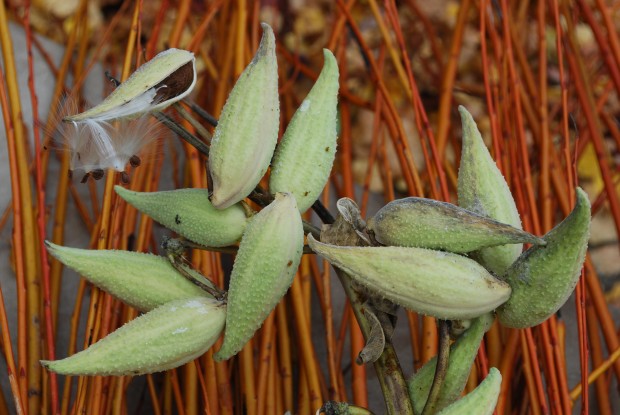 Asclepias has much to recommend. The plants are long lived, utterly drought resistant, and carefree. The flower heads of asclepias tuberosa are orange and gorgeous. Asclepias incarnata has flower heads that are a quiet shade of dusky rose. But my main interest in them is the seed pods. The pods are large, ovate, and a compelling shade of bluish green. In late summer, this green phase dominates the plants.
Asclepias has much to recommend. The plants are long lived, utterly drought resistant, and carefree. The flower heads of asclepias tuberosa are orange and gorgeous. Asclepias incarnata has flower heads that are a quiet shade of dusky rose. But my main interest in them is the seed pods. The pods are large, ovate, and a compelling shade of bluish green. In late summer, this green phase dominates the plants.
 Once the seeds begin to ripen, the pods will split along their length.
Once the seeds begin to ripen, the pods will split along their length.
 Our local fields and meadows are full of the remains of the milkweed pods come November. They have an elegantly spare and ruggedly persistent shape.
Our local fields and meadows are full of the remains of the milkweed pods come November. They have an elegantly spare and ruggedly persistent shape.
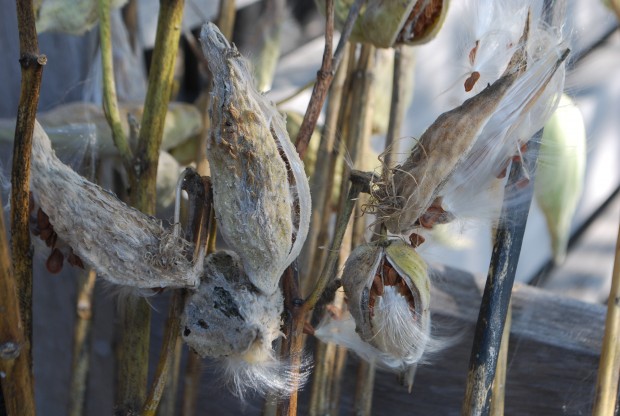 But the white fluff inside is what interests me the most. Each butterfly weed seed is firmly affixed to its own white silky and fluffy airplane. These white silky hairs catch the wind, and aid in the dispersal of the seed.
But the white fluff inside is what interests me the most. Each butterfly weed seed is firmly affixed to its own white silky and fluffy airplane. These white silky hairs catch the wind, and aid in the dispersal of the seed.
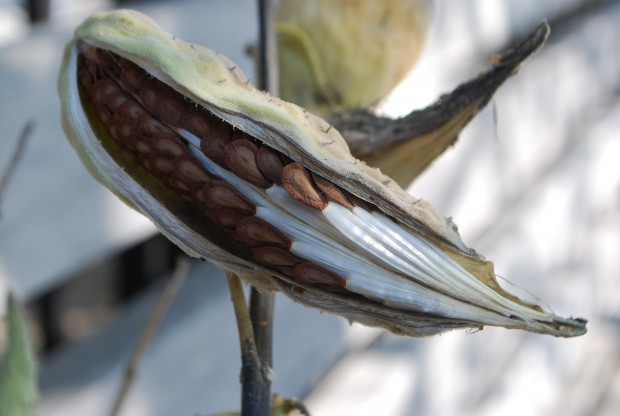 How plants set seed is an event any gardener would appreciate. How the milkweeds insure the survival of their seed is nothing short of miraculous.
How plants set seed is an event any gardener would appreciate. How the milkweeds insure the survival of their seed is nothing short of miraculous.
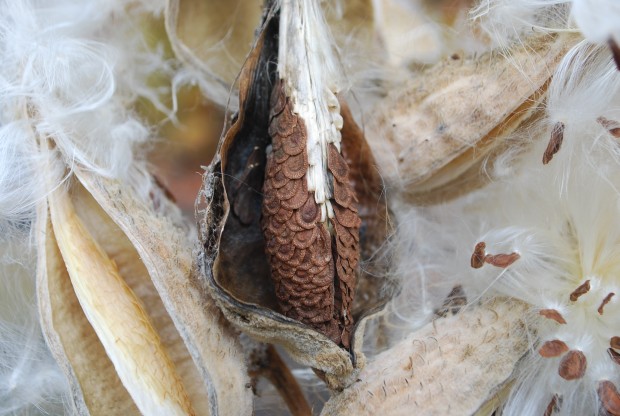 From Wikipedia: The milkweed filaments from the follicles are hollow and coated with wax, and have good insulation qualities. As of 2007, milkweed is grown commercially as a hypoallergenic filling for pillows. This commercial use does not interest me as much as how the butterfly weed seeds itself. A milkweed seed with its virtually weightless attendant white fluff is a little and subtle miracle I never tire of. Every year, the marvel of it enchants me.
From Wikipedia: The milkweed filaments from the follicles are hollow and coated with wax, and have good insulation qualities. As of 2007, milkweed is grown commercially as a hypoallergenic filling for pillows. This commercial use does not interest me as much as how the butterfly weed seeds itself. A milkweed seed with its virtually weightless attendant white fluff is a little and subtle miracle I never tire of. Every year, the marvel of it enchants me.
 Once those seeds emerge, that fluff is everywhere. It will stick to your hands, your clothes, your shoes, your trowel, and your wheelbarrow. An individual seed is large, and relatively speaking, heavy. How this plant has evolved to insure that these big seeds get dispersed is but one of countless stories engineered by nature. I have had occasion to design and install fairly complex landscapes, but this design and execution is beyond compare.
Once those seeds emerge, that fluff is everywhere. It will stick to your hands, your clothes, your shoes, your trowel, and your wheelbarrow. An individual seed is large, and relatively speaking, heavy. How this plant has evolved to insure that these big seeds get dispersed is but one of countless stories engineered by nature. I have had occasion to design and install fairly complex landscapes, but this design and execution is beyond compare.
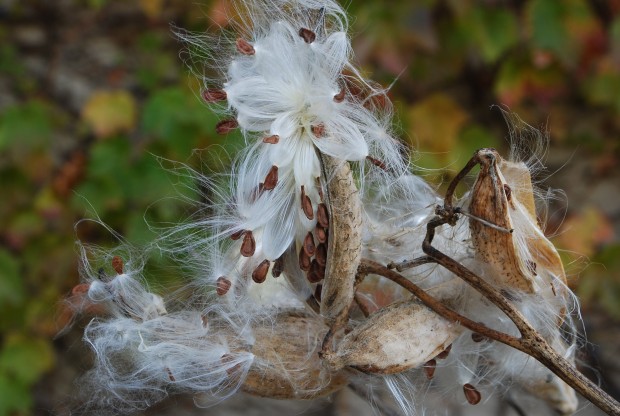 Any landscape designers best ally is what comes from the natural world. All it takes is a lot of observation, and then some serious thought. As my friend and colleague Susan Cohan says, art does not necessarily have to work. No artwork needs a white silky airplane to be. A work of art lives independent of time,conditions, and circumstance. Good landscape design is a craft, in that every moment needs to assess the conditions, fire up,and fly.
Any landscape designers best ally is what comes from the natural world. All it takes is a lot of observation, and then some serious thought. As my friend and colleague Susan Cohan says, art does not necessarily have to work. No artwork needs a white silky airplane to be. A work of art lives independent of time,conditions, and circumstance. Good landscape design is a craft, in that every moment needs to assess the conditions, fire up,and fly.
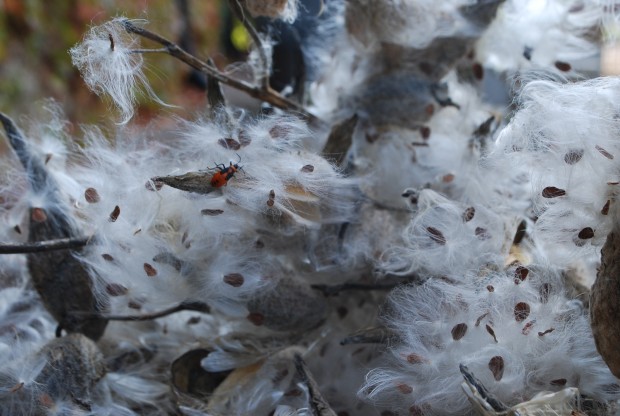 The milkweed seeds about to fly is a day in the gardening season I look forward to. I would hope these plants would find a foothold in many places. I like that the Monarch butterfly feeds and reproduces on a plant that has a plan to not only enable these beautiful creatures, but reproduce.
The milkweed seeds about to fly is a day in the gardening season I look forward to. I would hope these plants would find a foothold in many places. I like that the Monarch butterfly feeds and reproduces on a plant that has a plan to not only enable these beautiful creatures, but reproduce.
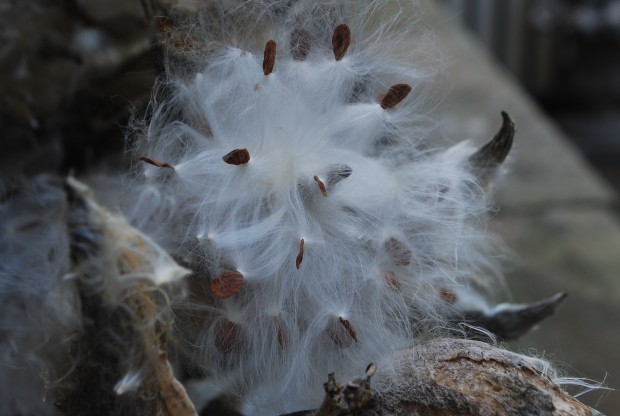 Much of gardening is about the physical issues. The dirt, the water, the drainage, the weather, the maintenance, the beginning, and the ending. But there are those singular moments that float.
Much of gardening is about the physical issues. The dirt, the water, the drainage, the weather, the maintenance, the beginning, and the ending. But there are those singular moments that float.
 There is a day every gardening season when I make the effort to launch the asclepias seeds. It feels good to think I am doing my part.
There is a day every gardening season when I make the effort to launch the asclepias seeds. It feels good to think I am doing my part.
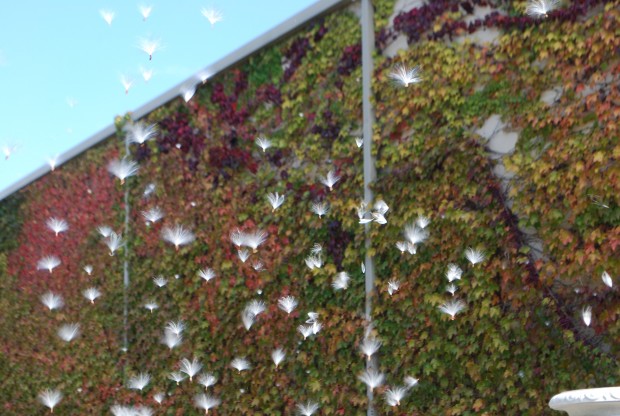 Do these seeds need me? No. Nature saw to this efficient dispersal long before I ever took up a trowel. But I do it anyway. This white fluff I put in the air makes me feel good.
Do these seeds need me? No. Nature saw to this efficient dispersal long before I ever took up a trowel. But I do it anyway. This white fluff I put in the air makes me feel good.